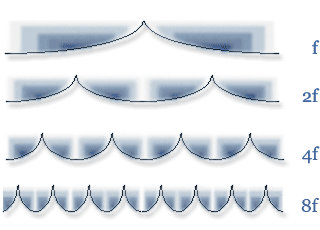Sound and tone
Sound is mechanic vibration that oscillates at a frequency within the range of the (human) ear. The vibration that propagates through air (or any other medium) creates pressure variations that are interpreted as sounds by the ear when the oscillations make the auditory membrane of the ear move. If the pressure variations are highly erratic, the resulting sound is noise. Recurrent, regular pressure variations, however, produce distinct tones with an observable musical pitch.
Sound propagates through air in the form of longitudinal sound waves with a speed of approximately 340 metres per second. The exact speed depends on factors such as temperature. As sound waves propagate through a medium, they create compressions and rarefactions. The volume of the sound depends on the pressure difference between these compressions and rarefactions.
The top wave in the figure below has only one compression [f]. It represents a single vibration occurring within a certain period of time. If two or more vibrations occur within the same period of time, they can be illustrated with the waveforms below the top one [f, 2f, 4f and 8f].

If the time period is a only couple of seconds, the individual vibrations can be heard as (for example) regularly repeating whooshing sounds.
When the number of pressure variations within a given period of time exceeds a certain limit (approximately 1620 variations per second), distinguishing them as individual sounds becomes difficult, and they gradually start to become audible as a pitch. If the frequency increases, the pitch of the sound rises. When the frequency exceeds approximately 10 000 oscillations per second, the human ear can no longer detect it. The sound can still be sensed as a whining, but making it audible requires a sound pressure that will invariably be experienced as unpleasant by the listener.

